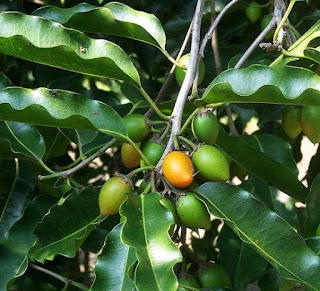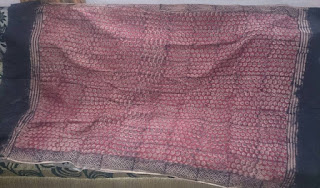Techniques of hand block printing
We can classify traditional hand block printing techniques into 3 categories which are:
1. Mordant printing or Syahi Begar printing (Bagh, Bagru, Macchalipattanam, Pedana, Tarapur)
2.
Resist printing mainly Dabu (Akola, Bagru, Kaladera, Tarapur, Udaipur)
3.
Combination of mordant & Resist Printing (Ajrakh, Balotra, Jahota, Nandana, Pharad, Puru & Taarapur print)
In Rajasthan by combining alizarin and resist printing techniques a new technique was developed mainly in Bagru and Balotara centers. In Bagru it is known as "Jahota" (Mixing of two). Due to regional beauty this technique practiced in Balotara known as Balotara printing.
In
Tarapur (Madhya Pradesh) this technique has been developed by Chippa community known as Tarapur print due to its regional specialty and use of design patterns.
In this blog post we are discussing about mordant printing. Rest of the printing techniques will be discussed in coming blog posts.
Mordant Printing
The
widely used mordant hand block printing technique is also known as "Syahi-Begar" or Alizarin
printing. Alizarin is a natural chemical which is extracted from the roots of
Madder(Rubia cordifolia) & bark of Al root (Morinda tnctoria) used to get natural red color where alum has been
printed and to fix the Black (Jaggery powder & iron rust printed on myrobalan dyed fabric) color. Today natural alizarin is replaced by synthetic alizarin.
The process of mordant based block printing is as follow:
Pre-Printing
Scouring of Fabric
(Purchase of kora/raw fabric)
Cleaning
(Locally known
as “HariTarana” and soak for 24 hours in a solution of castor oil, soda ash and goat dung)
Yellow dying/Pre mordanting
(Yellow dyeing with Harda(fruit of myrobalan plant) solution to make fabric
off-white. (Prepare fabric for printing locally called “PeelaKarna” or HardaRangai).
Printing Process
Color/Mordant preparation
(Alum water mix with tamarind seed powder to get red, Iron rust & jaggery fermented solution mix with tamarind seed powder to get black)
Printing
(Printing locally called “Chapai” is done with wooden block with mordant)
(Drying of printed fabric locally called “Sukhai”. It is kept in cool and dry place for 4 to 5 days so that printed color get absorbed by fabric threads)
Washing
(To remove the excess color locally called “Khulai”)
|
Dyeing or fixing of colors
(Dyeing the fabric with synthetic alizarin or madder roots or al roots with woodfordia fructicosa flowers locally known as dhawdi phool. The process of dyeing is locally known as “GhanRangai”)
Bleaching
(Previously natural bleaching process done near river by keeping fabric on sand under sunlight and sprinkle water on it for a whole day to remove the stains. Now a days ready made bleach powder is used in the process)
Fabric is ready for use/sale
(Source: Based on primary research)
It is also known as mordant printing because of use of mordants such as iron rust and fitkari (Alum) in the process. These 2 mordants mixed with tamarind powder paste before printing. In some places alum is mixed with gum Arabica (Babool gond) solution before printing. Before printing fabric is first dyed with myrobalan solution. Natural pigment known as tannin is present in myrobalan helps to get dark shade of black color after reacting with iron rust and jaggery paste printed on the fabric.
In Indian traditional hand block printing industry natural Alizarin was extracted from roots of Al tree (Morinda Tinctoria) commonly known as "Al Tree". Alizarin was the first natural pigment which was made synthetically in the lab in the year 1868. In India it got popularized some 50 years ago since then not a single hand block printing cluster using natural Al roots to get the red color.
Even present generation of hand block printers not only forgot the use of Al roots but also the process. Today al roots is used by tribes of Kotpad village in Koraput district of Orissa to dye the threads before weaving sarees.
Easy to use and cost effectiveness of synthetic alizarin made it popular among the hand block printers community in India so it has replaced the use of Al roots to get red color.
In this mordant printing now known as syahi begar printing only two colors red and natural black can be printed.
1. Bagh print (Dhar, Madhyapradesh)
2. Bagru print (Bagru, Rajasthan)
3. Bherogarh print (Ujjain,
Madhyapradesh): Now a hub of batik printing.
4. Kukshi (Dhar, Madhyapradesh)
5. Bela printing (Kutchh,
Gujarat)
6. Tarapur (Javad,
Madhyapradesh)
7. Sanganer (Sanganer, Rajasthan). Now a hub for pigment printing
8. Machilipattanam (Andhra Pradesh)
9. Pedana (Andhra Pradesh)
In Machilipattanam and Pedana this technique further developed and achieved the acme of traditional mordant based hand block printing. In these techniques now more than 2 colors can be printed by using 4 to 5 blocks.
In many other places
of Rajasthan and Gujarat Alizarin printing is also practiced apart from Dabu
and Ajrakh printing.
Printing (ठप्पा छपाई )
Washing (धुलाई)
Myrobalan dyeing (पीला करना)
ठप्पा छपाई के प्रकार
हस्त छपाई
या ठप्पा छपाई के प्राकृतिक रंगों का उपयोग करके
कपड़ो पर छपाई करने के मुख्यतः तीन प्रकार हैं:
1.
सीधे छपाई
(स्याही बेगर प्रिंटिंग)
२. बाधा
छपाई (दाबू,
अजरख)
३. उपरोक्त दोनों
छपाई का संगम
मोरडेंट छपाई
और बाधा छपाई की तकनीको को मिलाकर नयी तकनीक कई परंपरागत ठप्पा छपाई केन्द्रों में विकसित हुई| राजस्थान में यह बगरू और बालोतरा में मुख्य रूप से उपयोग की जाती हैं| बगरू में यह तकनीक जहोता (दो का मिश्रण) कहलाती हैं और बालोतरा में यह अपनी स्थानीय सौदर्य के कारण बालोतरा कहलाती हैं| , मध्यप्रदेश के तारापुर, में यह तकनीक छिप्पा समाज द्वारा
विकसित की गई जिसे इसके स्थानीय विशेषता के कारण तारापुर प्रिंट के नाम से जाना जाता हैं|
इस ब्लॉग पोस्ट में हम केवल मोरडेंट या सीधी छपाई की बात करेंगे| बाकी की छपाई तकनीको को हम दुसरे ब्लॉग पोस्ट में लिखेंगे|
सीधी छपाई
सीधे छपाई
की सबसे प्रचलित तकनीक को अलिज़रिन प्रिंटिंग के नाम से भी जाना जाता हैं| अलिज़रिन मुख्यतः मंजिष्ठ (रुबिया
कोर्दिफोलिया) की जड़ से निकलने वाला लाल रंग का प्राकृतिक केमिकल हैं| भारत में मुख्यतः आल (मोरिंडा टिंकतोरिया ) की जड़ और कुछ कुछ स्थानों पर मंजिष्ठ की जड़ का उपयोग प्राकृतिक अलिज़रिन को प्राप्त करने के लिए किया जाता था| जिसका उपयोग छपाई में उपयुक्त होने वाले दो
प्राकृतिक रंगों फिटकरी की छपाई पर लाल और काले (गुड़ और लोहे की जंग एवं हरड) रंग को पक्का करने में महत्वपूर्ण योगदान देता है|
यह मोरडेंट छपाई भी कहलाती हैं| मोरडेंट यानी की रंगाई करने के पहले किसी दुसरे पदार्थ से आधार तैय्यार करना| इस तरह की छपाई में लोहे की जंग और फिटकरी का प्रयोग किया जाता हैं| इन दोनो मोरडेंट को छपाई से पहले इमली के घोल में मिलाया जाता हैं| कुछ स्थानों पर बबूल के गोंद से बने घोल में मिलकर भी छपाई की जाती हैं| छपाई से पहले कपड़े को हरड
के घोल से रंगाई कर छपाई के लिए तैयार किया जाता हैं| हरड में टेनिन नामक नेचुरल पिगमेंट होता हैं जो लोहे की जंग और गुड से बने घोल की छपाई के समय प्रतिक्रिया करके गहरा काला रंग देता हैं|
पहली बार १८६८ में अलिज़रिन को कृत्रिम रूप से लैब में तैयार किया गया जिसके बाद से प्राकृतिक अलिज़रिन की मांग में कमी चली आती गयी| भारत में पिछले ५० सालो से कृत्रिम अलिज़रिन का उपयोग ठप्पा छपाई में धड़ल्ले से शुरू हो गया हैं जिसके कारण परंपरागत ब्लाक प्रिंटर्स आल की जड़ से प्राकृतिक अलिज़रिन के उपयोग की विधि भूल गए हैं क्यूंकि उसकी प्रक्रिया न केवल जटिल हैं बल्कि महँगी भी हैं| एकोफेब की टीम ने गहन अध्ययन के बाद पता किया की आल की जड़ का उपयोग आज केवल उड़ीसा के कोटपड़ इलाके के आदिवासी हथकरघा साड़ियो में बनायीं गयी डिजाईन को रंगने में करते हैं|
भारत में आज परंपरागत सीधी ठप्पा छपाई में केवल प्राकृतिक काले रंग का ही उपयोग हो रहा हैं| लाल रंग की डिजाईन को प्राप्त करने के लिए कृत्रिम अलिज़रिन का उपयोग किया जाने लगा हैं|
भारत में छिप्पा या खत्री समाज द्वारा अलिज़रिन प्रिंट तकनीक का उपयोग करने
वाले मुख्य स्थान थे और जहाँ आज भी किसी न किसी रूप में यह तकनीक जीवित हैं:
१. बाघ
प्रिंट (धार,
मध्यप्रदेश)
२. बगरू
प्रिंट (बगरू,
राजस्थान)
३. भेरोगढ़
(उज्जैन,
मध्यप्रदेश) अब यह बटिक प्रिंटिंग के लिए जाना जाता हैं|
४. कुक्षी
(धार,
मध्यप्रदेश)
५. सांगानेर
(सांगानेर,
राजस्थान) अब पिगमेंट प्रिंटिंग का गढ़ हैं|
६. बेला प्रिंटिंग (कच्छ,
गुजरात)
७. तारापुर
(जावद,
मध्यप्रदेश)
८. मछलीपत्तनम (आंध्र प्रदेश)
९. पेडाना (आंध्र प्रदेश)
मछलीपत्तनम एवं पेडाना में यह तकनीक और भी अधिक रूप से विकसित होकर अपने चरम पर पहुच गयी हैं जिसमे ४ से ५ ब्लाक का उपयोग करके २ से अधिक रंगों का समायोजन सीधी या मोरडेंट छपाई के द्वारा किया जा सकता हैं|
राजस्थान और
गुजरात के कई स्थानों में मुख्यतः दाबू और अजरख के आलावा स्याही बेगर प्रिंटिंग का भी
उपयोग किया जाता हैं|













